Peace lilies are graceful flowering tropical houseplants that are either happy, or sad, and very rarely anything in between. If you find the right position for your peace lily, it will grow and flower generously for decades, but if you plonk it clumsily in the wrong place… well, your peace lily will let you know.
Our ultimate guide to planting peace lilies explains everything you need to know about watering, lighting, and feeding peace lilies, with a few helpful hints derived from its natural habitat that tell us why it needs those conditions.
More...
What is a Peace Lily?
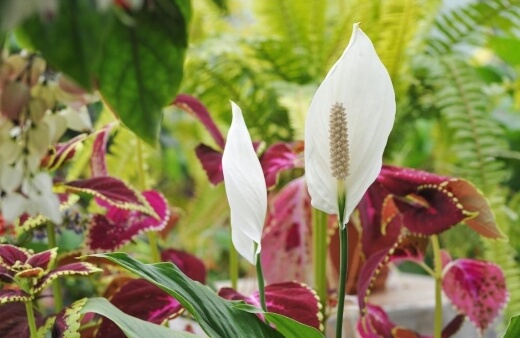
Peace lily, or Spathiphyllum wallisii, is a wide genus of nearly fifty species of flowering plants in the family Araceae, native to tropical regions of South America and South-East Asia.
Peace lilies are much more closely related to grass than the common garden lily, with monocotyledonous flowering heads producing seeds that contain a single leaf, which then spreads from the roots to form a lawn - hence why peace lilies clump so effectively and flower so readily all at once.
Peace lilies are tropical, shade-loving ground cover plants, which will grow indoors or outdoors in Australia, as long as they are protected from full sun and frost, but need lots of humidity, and regular feeding to get the most out of their flowers.
5 Best Peace Lilies to Grow in Australia
With fifty different species to choose from, you’d be forgiven for getting confused at the garden centre when you’ve got a range of peace lilies in different shades, different heights and different spreads, all being sold as semi-mature plants.
The reality is that peace lilies rarely grow taller than the height on sale in garden centres, and a healthy peace lily will reach full height in its first year, so what you see is what you get.
The more mature your plant grows, the more stems it will produce and the thicker your clump of peace lily ‘lawn’ will be in its pot.
1. Peace Lily Sensation (Spathiphyllum ‘Sensation’)Peace Lily Sensation is the biggest peace lily you can readily buy in garden centres, growing to between 1.5 and 2m tall when it flowers in late summer. The creamy yellow stamen stands out from the crisp white flower, and like even the smallest peace lilies, it tends to send all of its flowers up at once. So, you get a few weeks of intense drama followed by twelve months of beautiful architectural foliage. |  Source: Flowerpower.com.au |
2. Peace Lily Sonia (Spathiphyllum ‘Sonia’)Peace Lily Sonia is something a little bit different, with leaves and flowers that are about 50-60cm tall at maturity (exactly what you'd expect from an average peace lily) but much narrower leaves. There’s an authentic wildness to Peace Lily Sonia that you just won’t find with any other variety. | 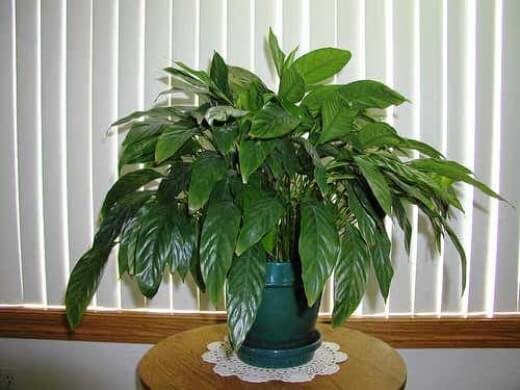 Source: Balconygardenweb.com |
3. Peace Lily Little Angel (Spathiphyllum ‘Little Angel’)One of the first houseplants we were given when we bought our first house was Peace Lily Little Angel. It’s lived on the mantelpiece in the living room for ten years, and I doubt it will ever move. Little Angel is a gorgeous dwarf peace lily, with more matte leaves than most peace lilies too, so it won’t show dust-up as much as other varieties but does tend to suffer more from bacterial infection than most waxy leaved peace lilies as a result. | 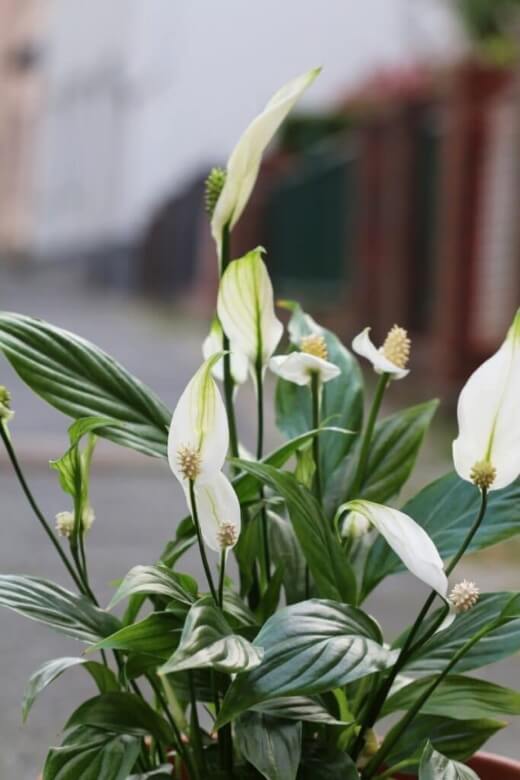 Source: florgeous.com |
4. Peace Lily Domino (Spathiphyllum ‘Domino’)Like any plant called Domino, you know it’s going to be variegated, but I was pleasantly surprised by Peace Lily Domino that it wasn’t overly bred to focus on the patterning and, in fact, had very delicate veining on constantly crinkled leaves. The leaves of Domino catch the light beautifully, and because they have a stronger structure than other large peace lilies they seem to be better at coping with occasional cool breezes. In our experience, that means that they work in the kitchen when the window is open once in a while, which makes great use of an often difficult location for houseplants. | 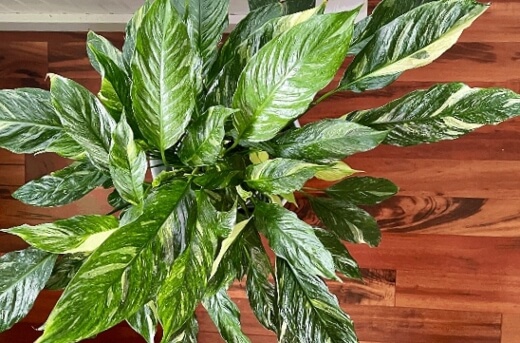 Source: Thecontentedplant.com |
5. Peace Lily Picasso (Spathiphyllum ‘Picasso’)I’ve been cajoled into including ‘Picasso’ in this list, but my partner is obsessed with variegated houseplants right now, so this is a relatively new inclusion to our collection. While we haven’t had it for that long, it does seem to be very affected by location, so really, really, needs to be positioned away from full sun, in mild-to-warm locations (19°C seems about right), and definitely, definitely, definitely, hates being dry. But what a show! | 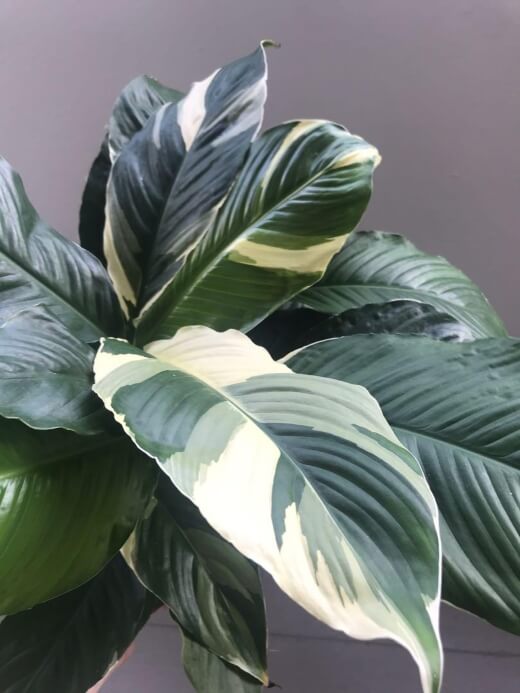 Source: Carousell.sg |
1. Peace Lily Sensation (Spathiphyllum ‘Sensation’)

Source: Flowerpower.com.au
Peace Lily Sensation is the biggest peace lily you can readily buy in garden centres, growing to between 1.5 and 2m tall when it flowers in late summer.
The creamy yellow stamen stands out from the crisp white flower, and like even the smallest peace lilies, it tends to send all of its flowers up at once.
So, you get a few weeks of intense drama followed by twelve months of beautiful architectural foliage.
2. Peace Lily Sonia (Spathiphyllum ‘Sonia’)

Source: Balconygardenweb.com
Peace Lily Sonia is something a little bit different, with leaves and flowers that are about 50-60cm tall at maturity (exactly what you'd expect from an average peace lily) but much narrower leaves.


Get Your Free Guide:
Master Growing Australian Natives eBook
A Must Have Complete Guide for Every Australian Garden
Get Your Free Guide:
Master Growing Australian Natives eBook
A Must Have Complete Guide for Every Australian Garden
There’s an authentic wildness to Peace Lily Sonia that you just won’t find with any other variety.
3. Peace Lily Little Angel (Spathiphyllum ‘Little Angel’)

Source: florgeous.com
One of the first houseplants we were given when we bought our first house was Peace Lily Little Angel. It’s lived on the mantelpiece in the living room for ten years, and I doubt it will ever move.
Little Angel is a gorgeous dwarf peace lily, with more matte leaves than most peace lilies too, so it won’t show dust-up as much as other varieties but does tend to suffer more from bacterial infection than most waxy leaved peace lilies as a result.
4. Peace Lily Domino (Spathiphyllum ‘Domino’)

Source: Thecontentedplant.com
Like any plant called Domino, you know it’s going to be variegated, but I was pleasantly surprised by Peace Lily Domino that it wasn’t overly bred to focus on the patterning and, in fact, had very delicate veining on constantly crinkled leaves.
The leaves of Domino catch the light beautifully, and because they have a stronger structure than other large peace lilies they seem to be better at coping with occasional cool breezes.
In our experience, that means that they work in the kitchen when the window is open once in a while, which makes great use of an often difficult location for houseplants.
5. Peace Lily Picasso (Spathiphyllum ‘Picasso’)

Source: Carousell.sg
I’ve been cajoled into including ‘Picasso’ in this list, but my partner is obsessed with variegated houseplants right now, so this is a relatively new inclusion to our collection.
While we haven’t had it for that long, it does seem to be very affected by location, so really, really, needs to be positioned away from full sun, in mild-to-warm locations (19°C seems about right), and definitely, definitely, definitely, hates being dry. But what a show!
How to Grow Peace Lily in Australia
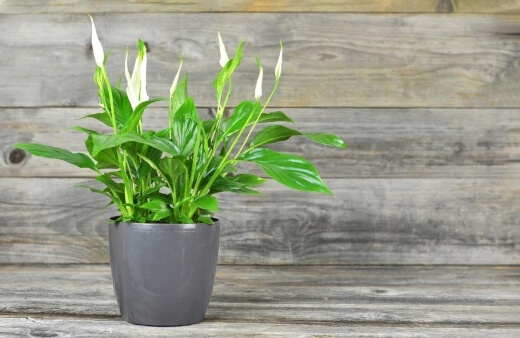
How to Grow Peace Lilies Indoors
Peace lilies can survive down to 7°C so can be kept anywhere in the house but somewhere bright and out of direct sunlight is perfect. Avoid placing peace lilies near windows though, as they are affected by wind-chill and regular cool winds will trick them into dormancy.
Keep peace lilies' soil moist (but not wet) by watering when the soil surface starts to look slightly dry. They do not enjoy drought at all and lose water through their leaves so benefit from regular misting to keep the leaves plump and green.
If your peace lilies are too wet its leaves will quickly turn yellow and droop, and the only course of action is to pull affected leaves and their roots out of the soil and dispose of them.
One really useful tip for peace lilies, especially in drier climates, is to regularly dust their leaves. Dust can quickly build on peace lilies which not only makes them look duller but actively prevents them from photosynthesising.
Wipe with a damp cloth once or twice a month as an alternative to misting.
How to Grow Peace Lily Outdoors
Peace lilies will grow outside in any part of Australia where winter temperatures are above 7°C and soil doesn’t get boggy. As long as they are well-drained, well-shaded, and well-fed, peace lilies can be an incredible garden or balcony plant in Australia.
Make sure peace lilies are planted in well-drained, moisture-retentive compost, and add grit to the base of the planting hole if you have clay soil so they never stand in water.
(Make your own compost using the best compost bins available today.)
Propagating Peace Lilies

The best way to propagating peace lilies is from division, as peace lilies grown from seed can take over four years to flower. But here’s our guide to get you started with your new plants, whatever option you choose:
How to Propagate Peace Lilies by Division
By far the most effective way to propagate peace lily is division. Because they grow like a lawn, with many plants in a single pot with an interconnected root system, you can simply pull the plants apart, and refill the pots with soil.
If you’re new to plant division, peace lilies are an easy place to start because you really can’t go wrong. Just pull them apart, and plant each half into two new pots the same size as the original pot. They will quickly start sending up new shoots and filling their new space.
Check out our video where Nathan Schwartz shows us how to propagate a Peace Lily:
Growing Peace Lilies from Seed
Peace lilies grown from seed takes over four years to flower, but can reach its full height in the first year so is a super cost-effective way to add verdant foliage to your home.
Before you start growing peace lilies from seed, it’s important to understand the challenges. Peace lilies can easily damp off as seedlings so rather than using a standard seed compost, invest in a coir compost, and mix it 50:50 with vermiculite.
This mix is great for peace lily, and once it’s rooted you can leave your young plants in their pots until they’re big enough to pot on. Start by sowing peace lily seeds into 9cm pots with your coir and vermiculite mix, then covering with a thin layer of vermiculite.
Water them well, and cover them with a plastic bag to keep them moist but not wet. Keep them on a warm windowsill for 1-2 weeks and you should start to see shoots appearing.
When shoots appear, remove the bag and keep the soil moist until roots fill the pot and the leaves start to resemble their full-sized plants.
Caring for Peace lily
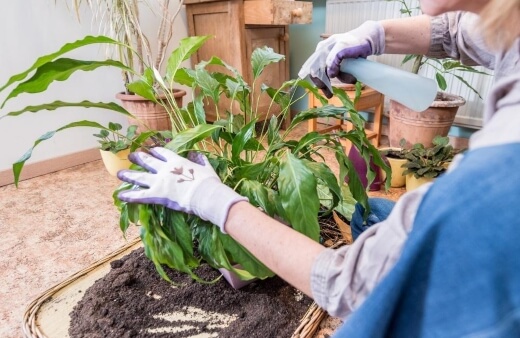
Peace Lily Light Requirements
Peace lilies will survive in a surprising amount of shade, but they prefer a bright spot out of reach of direct sunlight. Ideally, peace lilies should be placed on a table in the shadows of a North facing window.
They will benefit from the warmth of the window, without having to fight against the direct sunlight. This helps them regulate their moisture.
Direct sunlight can scorch peace lily leaves and the tips of leaves will turn brown and dry. Sadly, these brown tips can let other infections into the leaves, but by pruning (get the best pruning shears here) the entire leaves off and moving them to a slightly more shaded spot your plant will quickly recover.
How to Fertilise Peace Lily
Basic house plant fertilisers are great for indoor peace lilies, giving them balanced nutrients that replicate tropical conditions.
For outdoor peace lilies, you can use any organic plant food to boost nitrogen and potassium in the soil, or fertiliser them with composted kitchen waste, which gives a great slow-release boost at the start of the year.
Watering Peace Lilies
Water peace lilies every 1-2 weeks depending on its position. For peace lilies in warmer spaces, they are likely to need weekly water, as the soil will dry faster but peace lilies in shadier rooms are more likely to use water at their own natural rate without evaporation, so should only be watered when the soil is starting to dry.
Try not to let your peace lilies dry completely, as they do not cope well with drought. If you ever notice that the soil at the base of a peace lily is dry, water it generously, and let any excess water drain out of the base of the pot.
Peace Lily Pests and Diseases to Look at For
Peace lilies are incredibly productive plants and incredibly effective photosynthesisers. That makes them incredible houseplants, but also attracts insects that feed on the chlorophyll in their leaves, which can lead to common peace lily diseases like mosaic virus and leaf blight.
In the section below, we’ll explore how to spot and how to treat the most common peace lily pests and diseases.
Spider Mites
Early signs of spider mites are hard to spot on peace lily as their tiny bodies are only a fraction of a millimetre across, but if you have a particularly bad infestation you’ll start to notice silk sacks and silk thread hanging from the undersides of leaves.
Spider mites lay eggs in protective silk sacks this way to protect them from the eyes of predators (and gardeners).
When spider mites hit they feed on chlorophyll, which creates tiny holes in plant leaves that can lead to yellow or brown spots on leaves, which let bacteria and fungus get a grip.
To treat infestations use organic pesticides like neem oil and castile soap which kill spider mites on contact and dry without harming the plant.
Mealybugs
Mealybugs on peace lilies look incredibly similar to spider mites. While the insects themselves look entirely different, they both produce white clumps on the undersides of leaves, but with mealybugs, you’ll notice the white clumps are closer to the stem, and rather than contacting eggs, are actually the insects themselves, coated in a foul-tasting mucus that puts off predators.
The treatment of mealybugs is the same as spider mites, using neem oil to kill them without harming pets or pollinators.

Peace Lily Root Rot
There are two common causes of root rot in peace lilies, but both are a symptom of over-watering; Cylindrocladium root rot, and Pythium root rot.
Cylindrocladium root rot is a fungal infection caused by overwatering, while pythium root rot is caused by a water mould. Both cause the leaves to turn yellow and wilt.
The only treatment is to pull out all affected leaves, and if the affliction has taken a significant portion of your peace lily, to wash off all the soil, and repot your plants.
Mosaic Virus on Peace Lilies
Mosaic virus is a very accurate title for this peace lily disease, caused by bacteria spread between plants by aphids, mites and mealybugs that infect tools, soil and leaves.
The virus can be spread to the plant through its roots or damaged leaves and causes a mosaic pattern of yellow and pale green blotches all over the new growth of affected plants.
While the mosaic virus is unsightly, it doesn’t actually harm the plant's health, but to stop it from spreading to other houseplants, cut off affected growth.
Peace Lily Frequently Asked Questions
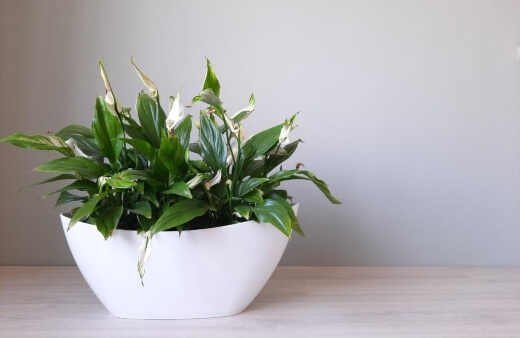
Are peace lilies toxic to cats?
Sadly, peace lilies are completely toxic to cats and can cause very sudden and often fatal illnesses. The entire plant is fatal to cats, but the flowers are particularly dangerous as they actively attract them with their intriguing fragrance.
Where should I place my peace lily?
Peace lilies like indirect sunlight, and hate cold temperatures, so finding the perfect spot in your home can take some trial and error. As a guide, make sure your peace lily is never within 1m of a north-facing window, and never within 1m of an active breeze.
Are coffee grounds good for peace lilies?
Coffee grounds are a useful additive for peace lilies, but rather than a fertiliser in their own right, act as a food supplement, which helps peace lily roots take up nutrients from other fertilisers more efficiently by lowering the soil pH.

Enjoy Growing Radiant Peace Lily in Your Home
With their white flowers and architectural anthers that come in all shades of white, cream, yellow, and green, there is so much to love about the humble peace lily. It might be one of the most gifted houseplants in the world, but it’s also one of the best.
I hope or ultimate guide to planting peace lily helps you to find the right spot for your new peace lily and, if nothing else, get to grips with peace lily light requirements, but we’re going nowhere, so you’re always welcome back to read more and remind yourself of the best way to grow peace lilies.
Published on February 2, 2022 by Maisie Blevins
Last Updated on February 12, 2024




